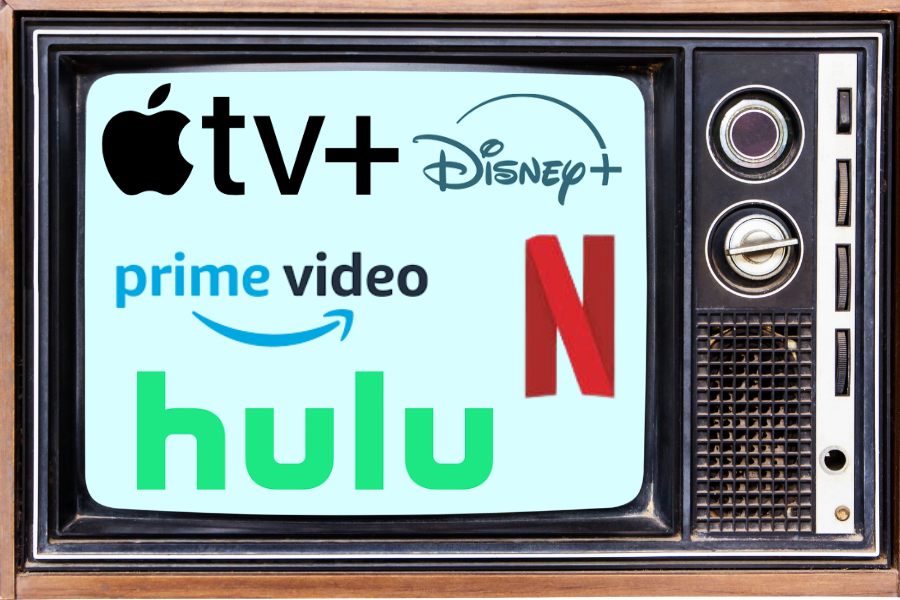The great battle between streaming giants has been fought since Netflix introduced on-demand streaming in 2007. Since then, companies unrelated to streaming, such as Amazon and Apple, have jumped into the 130-billion-dollar industry. With over two hundred streaming platforms across the world, from giants such as Disney Plus to smaller players like Fubo or Tubi, countless wallets have been torn open by these companies just to watch trending shows.
While streaming is the norm today, it’s necessary to understand how recent the shift from broadcasting was. Less than two decades ago, watching movies and shows meant relying on cable subscriptions and physical media. However, soon after Netflix switched to streaming in 2007, other large brands quickly entered the competition, with Amazon in 2011 and Apple and Disney following in 2019. With these major companies competing for subscribers and global reach, this streaming war has driven progress and innovation, completely revolutionizing the entertainment industry. Let’s take a look at how the big three are doing right now.
Netflix has been leading this industry, focusing on producing original content and utilizing data to make recommendations. This was evident in 2023 when more than 17 billion dollars were invested in the production of original content. Additionally, they have worked to redefine the way that customers watch entirely. By releasing entire seasons at once, rather than the traditional method of releasing episodes one by one, Netflix has led to the phenomenon of “binge-watching.”
Disney Plus has been a divisive service in the minds of Marvel and Star Wars fans. Originally, it was created so that these universes could be expanded on with TV shows, and that got many people excited. Ten million people signed up on the first day, and the combination of the backlog of classic Disney movies like Lady and the Tramp and blockbuster epics like Avengers lured people and their wallets in.
As Disney executives saw the money begin to print itself, they demanded that Disney Plus become the ten billion-dollar service that it is today. Shows seemed to be shoved out the door extremely quickly, and many, at first, were well-received. The Mandalorian and Falcon and the Winter Soldier both received mostly positive ratings, and fans of those respective universes couldn’t wait to see what was in store next. But once shows such as She-Hulk began being added to the streaming service, fans regretted all they wished for. In the quest for quantity, Disney Plus has gone down in quality, and it began hurting Disney’s movie business. So now, Disney Plus is scaling back its content output to increase the quality of its shows. They are also bundling with Hulu and ESPN+ to attract value-minded customers and, like Netflix, are pushing their ad-supported tiers. These strategies make sure they stay relevant even as people’s wallets begin to shrink.
Amazon Prime stays competitive by bundling its content with the Prime membership, giving easy access to customers and a unique advantage. By utilizing their established 200 million Prime subscribers, it increases the reach of the streaming platform. Amazon also integrates Prime Video into its retail website, offering deals on purchases and rentals. By using its vast data and network in its growing customer base, Amazon can easily recommend content based on habits and push other products relating to what is viewed by a specific customer.
This seamless connection between streaming and shopping ensures that Prime Video remains an essential part of the Amazon ecosystem, keeping users engaged across a variety of services. In addition to this, they continue to pump out shows from a wide range of genres to keep people hooked on the platform, such as The Boys, Invincible, and even Beast Games.
The streaming wars are no longer the cutthroat battle they used to be. Now, instead of trying to get as many users as possible, these services are trying to maximize their revenue from their existing users. If I have to award a top three, I would say the ones above have the podium. Netflix remains the top contender, followed by Prime Video and Disney Plus, purely based on the sheer number of users these services have. But in an ever-changing market, a clear winner cannot be truly crowned, as new technologies come and companies must constantly innovate to keep up with the demands of their customers and shareholders or face being tossed aside.
















































































